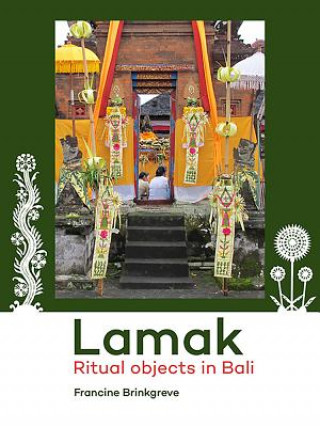
Kód: 14229844
Lamak
Autor Francine Brinkgreve
This is the first study to examine in detail ritual objects known as 'Lamak', a fascinating and unique form of ephemeral material culture which is a prominent feature of Balinese creativity. A lamak is a long narrow ritual han ... celý popis
- Jazyk:
 Angličtina
Angličtina - Vazba: Brožovaná
- Počet stran: 300
Nakladatelství: Sidestone Press, 2016
- Více informací o knize

Mohlo by se vám také líbit
-

This Misery of Boots
515 Kč -

THE PILGRIMS OF THE RHINE: TO WHICH IS A
1042 Kč -

MEMOIR OF MARY RICHARDSON, WIFE OF JOSIA
771 Kč -

Stories from The Road Not Taken
491 Kč -

NHS Experience
5061 Kč -

Autodesk Inventor 2014 - Aufbaukurs KONSTRUKTION
700 Kč -

Betharram
390 Kč
Dárkový poukaz: Radost zaručena
- Darujte poukaz v libovolné hodnotě a my se postaráme o zbytek.
- Poukaz se vztahuje na celou naši nabídku.
- Elektronický poukaz vytisknete z e-mailu a můžete ihned darovat.
- Platnost poukazu je 12 měsíců od data vystavení.
Více informací o knize Lamak
Nákupem získáte 197 bodů
 Anotace knihy
Anotace knihy
This is the first study to examine in detail ritual objects known as 'Lamak', a fascinating and unique form of ephemeral material culture which is a prominent feature of Balinese creativity. A lamak is a long narrow ritual hanging that is an essential requirement at almost all rituals in Bali. It is hung from altars and shrines at temple festivals and on festive holy days. Made usually of palm leaves, it is by nature ephemeral and it is made time and again. Even though permanent forms of the lamak, made of cloth or coins, do exist, the ephemeral palm leaf form must be present. Sometimes reaching a length of several metres and decorated with a range of motifs, its most elaborate forms are made by specialist craftsmen and women. The lamak serves as base for offerings and attracts deities and deified ancestors to them. Decorative motifs representing sources of life are ordered according to Balinese concepts of the vertical structure of the cosmos. Best known among the motifs is the cili, a human figure in female form that symbolizes human fertility and regeneration. Through offerings and the active role of the lamak, worshippers offer thanks to their deities and request prosperity and protection. Despite decades of change and modernization that have affected all aspects of life in Bali, the essential role of the lamak has survived intact. Although there are many studies of Bali's internationally appreciated arts and crafts, this is the first one to examine in detail this fascinating and unique form of ephemeral material culture which is a prominent feature of Balinese creativity. The study answers the question: why do Balinese make lamak and why do they continue to make them time and again? It examines the use and function of the lamak in ritual, the motifs that decorate them, the materials and techniques to make them, regional and individual styles, and processes of change and commercialization. Contents 1. Study of lamak 1.1 Lamak in Bali anno 2014 and 2016 1.2 Subject and structure of the book 1.3 Lamak and western scholarship 1.4 Framework and inspiration 1.5 Methodology 2. The lamak as ritual object 2.1 Inspiration 2.2 Rituals in Bali 2.3 What is a lamak? 2.4 What do the Balinese do with lamak? 2.5 Galungan and odalan 2.6 What is the purpose of a lamak, what does it do? 2.7 Conclusion 3. Motifs of life 3.1 Insight 3.2 Motifs on lamak 3.4 Relations within and among motifs 3.5 Conclusion 4. Ephemeral and permanent lamak 4.1 Lamak makers at work 4.2 Ephemeral and permanent lamak 4.3 Palm leaf lamak 4.4 Permanent lamak 4.5 Ephemeral and permanent lamak compared 4.6 Conclusion 5. Lamak and their social network 5.1 Ni Ketut Pilik, 1988 and 2013 5.2 Lamak and their social network 5.3 Lamak makers and entrepeneurs 5.4 Style: diversity and development 5.5 Conclusion 6. Why the Balinese make and remake lamak 6.1 Lamak, ritual and ephemerality 6.2 Lamak, visual communication and agency 6.3 Interrelatedness of different aspects of lamak 6.4 Continuities and change in relation to lamak 6.5 The active life of a lamak
 Parametry knihy
Parametry knihy
1970 Kč
- Plný název: Lamak
- Autor: Francine Brinkgreve
- Jazyk:
 Angličtina
Angličtina - Vazba: Brožovaná
- Počet stran: 300
- EAN: 9789088903908
- ISBN: 9088903905
- ID: 14229844
- Nakladatelství: Sidestone Press
- Hmotnost: 756 g
- Rozměry: 280 × 210 × 16 mm
- Datum vydání: 15. November 2016
Oblíbené z jiného soudku
-

Dune
249 Kč -

Haunting Adeline
621 Kč -

Berserk Deluxe Volume 2
1092 Kč -

White Nights
71 Kč -

Powerless
268 Kč -

Atomic Habits
330 Kč -

Dune Messiah
228 Kč -

Berserk Deluxe Volume 3
1142 Kč -

One Day
221 Kč -

Berserk Deluxe Volume 1
1115 Kč -

Iron Flame
368 Kč -

Surrounded by Idiots
213 Kč -

Harry Potter and the Prisoner of Azkaban (Minalima Edition)
993 Kč -

Gravity Falls Journal 3
441 Kč -

Heaven Official's Blessing: Tian Guan Ci Fu (Novel) Vol. 1
430 Kč -

The Creative Act
568 Kč -

Dune
276 Kč -

Hunting Adeline
624 Kč -

A Little Life
268 Kč -

Children of Dune
230 Kč -

Heaven Official's Blessing: Tian Guan Ci Fu (Novel) Vol. 2
427 Kč -

Bungo Stray Dogs, Vol. 8 (light novel)
382 Kč -

Percy Jackson and the Olympians 5 Book Paperback Boxed Set
944 Kč -

Solo Leveling, Vol. 1
440 Kč -

The Prisoner's Throne
247 Kč -

Court of Thorns and Roses
206 Kč -

Cry Baby Coloring Book
276 Kč -

Fourth Wing
444 Kč -

Icebreaker
205 Kč -

Berserk Deluxe Volume 6
1089 Kč -

Avatar, the Last Airbender: The Kyoshi Novels (Box Set)
968 Kč -

The 48 Laws of Power
608 Kč -

House of Leaves
611 Kč -

Twisted Lies
213 Kč -

Dune Messiah
277 Kč -

No Longer Human
311 Kč -

48 Laws Of Power
331 Kč -

Twisted Games
213 Kč -

Caraval Paperback Boxed Set
902 Kč -

Solo Leveling, Vol. 2
437 Kč -

Open Circuits
907 Kč -

Berserk Deluxe Volume 5
1119 Kč -

Heaven Official's Blessing: Tian Guan Ci Fu (Novel) Vol. 3
429 Kč -

Berserk Deluxe Volume 4
1125 Kč -

Court of Mist and Fury
206 Kč -

SOLO LEVELING V08
436 Kč -

English File Upper Intermediate Multipack A (4th)
487 Kč -

CHAINSAW MAN V14
254 Kč -

Before the Coffee Gets Cold
198 Kč
Osobní odběr Praha, Brno a 12903 dalších
Copyright ©2008-24 nejlevnejsi-knihy.cz Všechna práva vyhrazenaSoukromíCookies



 Vrácení do měsíce
Vrácení do měsíce 571 999 099 (8-15.30h)
571 999 099 (8-15.30h)